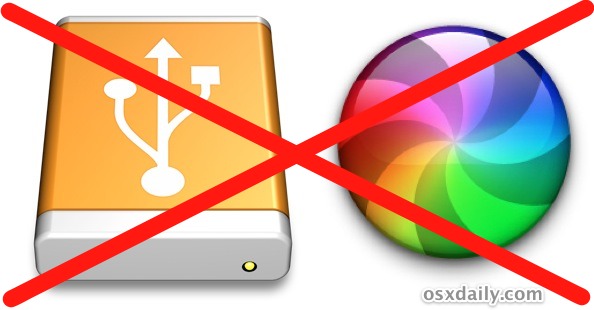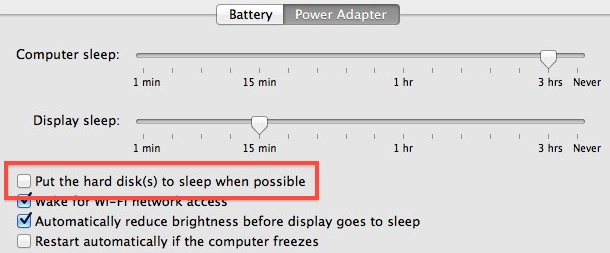Prevent Beachballs & Slow Downs in Mac OS X When External Hard Drive is Attached

Many Mac users have an external hard disk for Time Machine backups or other media storage purposes, and if you leave it connected to the Mac all the time you’ve probably noticed an annoying side effect: the drive will spin down when it’s not in use, only to be spun up again unnecessarily at random during unrelated operations.
That drive spin up time is waking the disk from its sleep state which can lead to some pretty serious system dragging even on the fastest Macs, and as a result you’ll often encounter a lengthy beachball cursor that slows down a Mac as you wait for the external drive to arise from sleep. There are a couple possible remedies for this problem, read on to understand the pros and cons of both choices.
Option 1) Stop Hard Disks from Sleeping

By checking this option the external (and internal) hard disks will not spin down to sleep while not in use, this will completely prevent the drive waking lag time and beachballs, however it can also reduce the lifespan of traditional spinning hard disks. For that reason it’s best to use this option sparingly unless you don’t mind the possibility of a shorter drive life for both the internal and external hard drives. If you leave your computer turned on all the time rather than sleeping or shutting down, this is probably not the best option to use.
Option 2) Unmounting Hard Disks When Not in Use
Another solution is to simply unmount the external hard disks when they’re not in use, this will also prevent them from spinning up at random or when a open/save dialog box appears. The downside to this approach is you’ll have to manually mount the drive when you do want to use it, and Time Machine backups will not take place when the drive is unmounted.
Unmounting Disks
You can unmount a hard disk without physically detaching it by either:
- Dragging the external disk to the Trash
- Or, using Disk Utility to unmount the drive
Remounting the Hard Disks
If you choose this option, you can remount the drives again using the Disk Utility app to regain file system access. Remounting is just a matter of doing the following:
- Launch Disk Utility and select the unmounted drive from the left side, unmounted drives will be grey
- Click the blue “Mount” button in the toolbar to remount the drive
- Exit Disk Utility
You can also physically disconnect external disks which has an added benefit of providing for a faster boot time, but that’s a pain and really isn’t a valid fix.
None of the solutions outlined above are particularly ideal and hopefully a revision of Mac OS X will change the behavior of how external hard drives are accessed so they are only spun up specifically when they are selected or used. I have encountered several individuals who mistakenly think this drive accessing behavior is their brand new Mac somehow being slow, which tells me this is a problem that should be addressed in a better fashion.
If you’ve found a better way to handle this speed problem, chime in with your thoughts or solutions in the comments.


My solution to this problem was using a Time Capsule which worked great… except now the TIme Capsule seems to be dying… and I am wondering what to do now.
What have you fellow impatient geniuses come up with? I’m not familiar with NAS drives, and they seem to have problems with TM…
So what now???
Thanks!
Barry
I have a 4 month old iMac 27″ with Time Machine backing up to a WD My Book Thunderbolt drive that turns on and off with the Mac. Mac startup is fast with minimal delay.
Recently, I added an Apple recommended 12TB G-Tech drive that cannot be turned on with the Mac, it has to be turned on individually. If this drive turned off when I boot the Mac, it takes almost 3 minutes to start up! Turn this drive, which I don’t always want to use, on first, the Mac boots within seconds. Inconvenient, to say the least.
It’s July 2016 and it’s still happening to me. However, I am still on 10.10.5.
I say we start a revolution and make Apple fix it!!! The above mentioned resolves aren’t really resolves. Yes both stop the problem, but the problem is Apple. It should not be waking the drives… Drives are made so cheaply now a days, leaving it run is my concern. Only the good old drives needed ventilation because they kept working. Now a days, as a tech I replace far too many Apple Drives, let alone the others. Unmounting the backups is not a great solution.
Why does Apple treat us this way???? Besides being repetitively annoying, it waste too much time. What a great user experience…
Is there any solution for this problem?
Yes, the solution to the beachball in OS X problem is described here: https://osxdaily.com/2012/05/14/prevent-slow-down-mac-os-x-external-hard-drive-access/
Far as I am concerned neither of these solutions is preferred, and I know everyone agrees. Does anyone know WHY this is happening suddenly? It’s very annoying. I’ll go to open a Word document that lives on the internal hard drive, yet one of my external drives will decide to spin up and it stalls the entire computer. Multiple times per day.
I am a photo editor and slow Mac is fast headache for me. Thanks a lot for these useful tips. Personally I found that having abundant amount of free space in boot volume keeps your Mac faster.
I found the best way is to access your external hardisks via an Airport Extreme or Time Capsule. A network drive will spin up from time to time, but it will not be a drag on your system.
The only downside is that you are limited to USB2 speeds, which is fine for Time Machine backups or other media storage purposes. For video work I rely on my external Firewire hardrive, but I keep that harddrive off when i’m not editing.
Note that you need a powered USB hub to connect multiple hard disks to the airport extreme.
If you have a laptop you can turn off time machine back up when on battery power.
Oh yeah, Drag & Drop these Folders to Privacy Window if you use them: DropBox, SkyDrive, Google Drive, etc… & /User/Downloads
Time Machine Editor: http://timesoftware.free.fr/timemachineeditor/
It’s FREE.
“Time Machine in Lion is working fine. I previously reported it as not working. However, I forgot that you need to turn time machine OFF for the schedule to change.”. http://roaringapps.com/app:1724
I have used it for years. Always worked fine for me, too. I schedule two backups daily, one in the wee hours of the morning when I’m usually asleep, and one in mid-afternoon when I am most likely to be away from my iMac.
Also disable spotlight indexing. Very useful especially on large drives
Or you could use this script (install it to run at startup and every 5 minutes or so with something like Lingon if you don’t know how to do it manually):
#!/bin/bash
# Used to not let a volume named Extras or More sleep
# Replace volume names with any volumes you wish to keep spun up
Volumes=”Extras More SL2″
for I in $Volumes
do
touch /Volumes/${I}/.nosleep
done
Option 1:
– Open System Preference/Spotlight/Privacy
– Drag & Drop these Folders to Privacy Window:
/private/tmp
/private/var/folders
/private/var/tmp
/private/var/vm
/Library/Caches
/System/Library/Caches
/Users/machacks/Library/Caches
/Users/wbs/Library/Saved Application State
– Unchecked UN-necessary Search Results in System Preference/Spotlight
Option 2:
Open Terminal & type:
sudo launchctl unload -w /System/Library/LaunchDaemons/com.apple.spindump.plist
# Disable “Writing Hang Reports to Disk”
That’s DISKSOMNIA… not Diskcomnia as in my first post.
Also, leaving the drives on is FAR better than the constant spin up/spin down cycling and is hell on the bearings. If your drives are properly placed and ventilated, there shouldn’t be heat issues.
Try using Diskcomnia as I have found it to work rather well with hard drives that follow the so-called Green Standard for energy efficiency.
I’ve got my iTunes library of files on a large 1TB external drive and it was really annoying me to have to wait for the spinning beach ball every time while the drive spun up to access the file. REALLY annoying if you’re a DJ using iTunes for casual parties!!
It works for both internal and external drives but NOT for Network attached drives. $9.99 for the full version and worth it. Here’s the website for it:
http://www.digital-heaven.co.uk/disksomnia
Updated to work with Lion
I encounter this every time I go to save or open something, you hear the vrrrrroooom as the drive spins up despite never using the thing except for Time Machine.
This is very frustrating and I wish there was a better solution. I think with Apple moving to SSD’s though it will probably not be addressed because the hardware will eventually resolve it.
I often have this problem with my time machine backup and another 2tb WD hdd.
I don’t like the idea of the HDDs never sleeping as my comp is on quite often.
Maybe things will be different in mountain lion.
I didn’t really experience this problem so much in slow leopard…